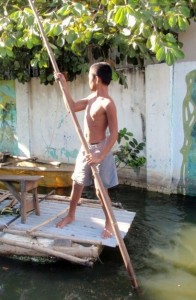
A boy rows a skiff down a flooded street in Rizal Province, Philippines
I was sitting in my hotel room in Macau, when a newsflash came across the television about catastrophic flooding in the Philippines. Provinces outside Manila had been ravaged by another typhoon–the third in the last month–causing a number of low-lying areas to be inundated with water. A waterborne illness called leptospirosis was also ravaging the affected areas. I wanted to see how people coped in a world overrun by water, so I booked a ticket the next day.
I flew into Manila and reserved a hotel room in Quezon City to situate myself closer to the flooded provinces. I arrived at dark by bus. It was a confounding place to be dropped off after a long day of travel. The streets were teeming with people and bright silver jeeps (called Jeepneys), which were spray-painted with exotic designs and blared music. This was public transport, I was told.
My hotel was close to the bus station, but to reach it I needed to climb an elevated footbridge that hung over the crowded avenue. The steps were dark, and at the top I almost slammed into a legless man who was sitting in the middle of the walkway. His head was hung downward, his eyes facing the ground. His right arm was outstretched and held a paper cup full of change and I dropped a coin in it–though, when it plinked against the others, he didn’t budge.
A blind man was playing a muddy, yet surprisingly sound version of Eric Clapton’s Layla a few feet down, with a sign hung around his neck describing his plight. I weaved around him, bypassed a beckoning prostitute and hustled down the stairs of the footbridge and into my adjacent hotel.
The next morning, I met with the OXFAM relief team that was working in the Rizal provinces, where most of the flooding had taken place. The first storm, they informed me, had been Ketsana, and it had caused most of the damage. The flood refugees numbered in the thousands. They had been evacuated to a number of shelters, but in the following storms, many of those shelters had been flooded as well.
The cause of the flood wasn’t just nature; but man, too. Most of the victims were squatters who had settled in areas on the border of various tributaries. Their refuse had gradually clogged water passages, preventing the flood waters from draining properly.
I went to Rizal Province later that day and saw the flooded neighborhoods with my own eyes. The streets had become canals, and taxi drivers congregated in a circle offering a number of homemade skiffs for transportation. The main evacuation center was a hub of activity, but had taken on approximately a foot of water, which residents splashed through.
I hired one of the boatmen and proceeded through the neighborhood. It was mostly deserted–the water neck-deep in some spots–but I did spy one couple napping on top of their home. They had managed to set up a pair of functioning speakers, and Michael Jackson ballads drifted through the air. Many of the other residents shared a surprisingly jovial attitude–especially the children, who swam playfully in the disease-ridden water.
One of the converted evacuation centers was a Presbyterian church, run by Korean native Armando Guiraldo. Guiraldo told me the church was housing approximately 50 families. “We are sad because our homes were destroyed, but we are happy because we have so much community relief,†he said, adding that he still holds church service every Sunday.
Relief workers noted that the neighborhood had extremely strong communal ties and the cohesiveness was partly responsible for the high spirits, but even they expressed surprise at the peaceful and positive attitude of residents. Inside Guiraldo’s church, children giggled and played soccer, while mother’s hung laundry and prepared food. There was no vibration of panic, none of the wild fear one would expect to accompany the destruction of homes. People had simply made an adjustment–as radical as it may sound–from living on dry to land to living in a flood zone. Even the stray dogs, who sunned themselves on narrow planks of wood, looked perfectly at home.
For more images of flooded areas in the Philippines, check out the photo gallery.
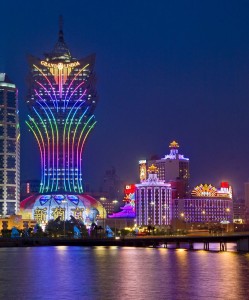
The Macau Skyline
Macau–Macau is a special administrative district located 40 miles from the coast of Hong Kong. It’s a former Portuguese colony, currently controlled by the Chinese. Like Hong Kong, it enjoys considerable independence. There is no gambling on the Chinese mainland, but there are 18 casinos in Macau. There is more gambling than any city in the world, including Las Vegas.
I went there to play Texas Hold Em. I’d yet to cash in on the American Dream, so I figured I’d give it a whirl on the other side of the globe. The slogan for Macau, as advertised on countless tourist buses and signs, is The City of Dreams. But what sort of dream is Macau trying to realize?
The peninsula–where most of the population resides–is a schizophrenic place, with two different identities wrestling each other for control. You can experience the contrast most vividly at dawn. My first morning, I woke up freakishly early and took a jaunt to a park above my hotel. A number of newly paved running trails weaved through the woods. There were fountains and park benches alongside congregations of sage-looking Chinese men performing Tai Chi.
As I navigated my way upwards in elevation, I reached Guia lighthouse, formerly used by the Portuguese to defend the city from invaders. From there, I could see the whole peninsula; it looked like two worlds smashed into one. In the foreground sat rows of narrow avenues crowded with dilapidated apartments, hole-in-the-wall restaurants, laundrymats, spice stores and other local businesses. In the distance, towering casinos shot into the air like gilded geysers and brandished huge, illuminated signs beckoning patrons.
A dawn later, as the first rays of sunshine began to illuminate the city, I was inside the gambling maw, seated at the poker table at the Grand Lisboa Casino. I had intended to leave hours earlier, but around three a.m. two Chinese men wearing outlandish sunglasses and designer shirts had plopped down at my table with a 50,000 Hong Kong Dollar marker.
“Those guys are junket,” a British expat said to me.
“What’s the junket?”
“Most Chinese high rollers take out a loan with loan sharks in Macau. If they lose it, guys like that track them down in the mainland and either collect or machete their heads off. “
He added that the Junket were notorious for being extremely aggressive poker players. Sure enough, within five minutes of arriving at the table, they were stacking off with marginal hands and immediately reloading. They bet with the body language of men who use money as power. They didn’t slide their chips into pots; they picked them up in a single column and slammed them on the felt.
The other players at the table became unnerved by their presence. They were either intimidated by their strong bets, or induced into calling with terrible hands by the allure of breaking them for a big pot. Soon, the junket duo was rolling up big stacks. Then, a man sat down at the table, who I will never forget.
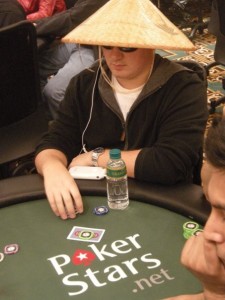
He was broad-shouldered with sandy, brown hair and a looseness in his movements that signaled a modest, yet intimidating confidence. He was silent and issued no greetings upon arriving, but simply bought in for the maximum. Then, from a plastic bag sitting next to him, he pulled out a pair of sunglasses and a large straw Vietnamese peasant hat. There was a chorus of laughter at the table, but the stranger’s lips didn’t even crack a smile.
Two hours later, I trailed him out of the casino into the brutal heat of the early morning sun. He had broken the junket–taken all their money with shocking ease– and sent them fleeing to the Baccarat table. He had not spoken a word the entire time. He was an enigma–a silent assassin–and as he left, his arms weighed down with chips, I dashed after him, only to watch him tip his hat to me as he peeled away on the back of a silver Kawasaki.
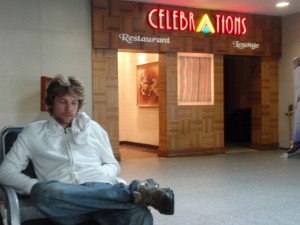
A tortured passenger awaits his fate in Mumbai
We were sprawled on benches, chairs and countertops in a restaurant called Celebrations. There were fifteen of us from a half-dozen countries. Some had resigned themselves to fate and drifted into slumber, but it was a painful sleep. Their bodies were twisted and stuffed into agonizing positions to fit onto a bench or a chair. A few stalwarts, including myself, were drinking at the bar and getting angrier by the minute. We wanted blood.  We wanted the blood of a man who promised us salvation and then ripped it away.
Our flight from London to Mumbai had been delayed when a passenger suffered a heart attack, forcing us to land in Budapest. For this reason, we arrived around midnight and missed our connection to Hong Kong. Jet Airways officials showed no sign of concern. They simply herded us into a restaurant and explained that there were no flights to Hong Kong until midnight tomorrow. We would have to wait in the airport for twenty-four hours, because Indian immigration would not grant us one-day visas to stay in a hotel. We would not receive any compensation. We would not even be allowed in the fancy lounge with the comfortable chairs and wireless Internet
Of course, it didn’t happen exactly like that. It wasn’t one swoop of bad news, but a long protracted drama in which we were kept in the dark as much as possible, until the gory truth had to be revealed. At first, we knew nothing. Then, the first rumors of the delay crept in. After that, we heard about the problems with immigration. We worked ourselves into frenzy, speculating on our future, until a customer service agent finally descended into the restaurant and delivered the news.
The crowd was rabid. The agent had the appearance of a human being, but her unflinching robotics made me question if she was perhaps a mirage. As she stood, reiterating her sentence, I snuck behind her and poked her gently in the fold of her bicep. Her flesh felt squishy and real, yet she didn’t react to my prodding.
After she departed, they fed us, but we continued to be charged mercilessly for beer. Then, around 6 a.m., those still awake began to buzz with the unmistakable hum of rumor. I poked my head into a group and found out there was a flight to Bangkok in two hours. You could go there and fly to Hong Kong, if you wanted. My cohort and I didn’t care about Hong Kong anymore. We had no business there. Bangkok would work fine.
I located the agent just outside of the restaurant, huddled conspiratorially with three or four other passengers. They weren’t friendly to my intrusion, as seats were limited, but after a bit of finagling I arranged two tickets. The agent left and said he would be back in an hour. We would be spared.
We went to the bar and toasted our good luck. We finished a round and nervously ordered another, followed by one more. Then, the terror struck. No one had wanted to comment on what was happening, as if pronouncing the obvious would make it more real, but finally an Englishman crumbled onto the bar, clasped his hands over his face and violently cursed the agent. “That prick; he’s not coming back,” he said.
We couldn’t find him; they wouldn’t let us past security. We wondered if he had done it just for the sick fun of watching us squirm. But it didn’t matter. It all quickly became a blur.
I slumped onto a couch and oscillated back and forth between consciousnesses like a pinball. The restaurant filled up and the bright lights and clatter of dishes and conversation made it impossible to sleep. I was kicked out of the VIP lounge twice, maybe three times. Finally, I broke down and handed over my credit card. The price didn’t matter; I just wanted one of those black leather recliners. I would have given my life for it. I had been debased beyond the point of recognition.
The Jet Airways officials returned to Celebrations restaurant around six p.m. the next day. They led us, like tranquilized dogs, through a maze of security checks and luggage claims before finally shoving us onto a plane. They are, by far, the coldest, most brutal individuals, I have ever encountered. It seems unfortunate that they have chosen the airline business as their base of operations. It would be much more appropriate if they were employed as enforcers in a Gestapo. I would prefer to be waterboarded and have my genitals mangled by electric shock than ever fly their airline again.
This is the first of a number of posts I’ll be writing about my travels in Asia. Check back for more articles or read my previous posts on West Africa.
This is the fifth of six posts I’ll be writing about the witch camps of Northern Ghana. You can find additional posts below.
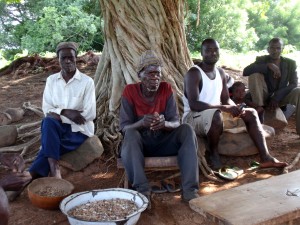
The chief of the Yendi camp alongside accused wizards
Simon picks me up at 5 am. It is not yet dawn but the moment preceding it, and I can feel the impending energy of the sun pressing violently against the black clouds. The motorcycle weaves jaggedly across the dirt road and past the prison, the canteen and the hot yellow Western Union that signifies the end of town. The sun punches through the clouds, flooding the plain with a soft, purplish glow. Men, women and children pour out of the bush and onto the road, proceeding toward town with baskets of goods on their heads.
Simon and I are going to Yendi, to visit Ghana’s biggest witch camp, which holds over seven-hundred individuals. The village was the site of a small war–more aptly described as a chieftaincy crisis–in 2003. The violence was the result of a long-lasting dispute between the Abudu and Andani tribes, which vie for power in the area. The conflict began when a mob stormed the palace of the sitting Ya-Na ( the regional chief), beheaded him and then killed another forty townspeople. In the aftermath, only a few of the perpetrators were brought to justice, and hostile tensions still hover in the area.
The witch camp in Yendi is not actually located in the town, but about forty kilometers outside of it. Before we begin the trek, we visit with members of Songtaba. a non-governmental organization (NGO) that advocates for those accused of witchcraft. The organization is coordinated by Enoch Cudjo. A college graduate with a degree in social work, Cudjo is young and brash. He wears a bright purple dashiki and, like others, is a bit nervous about talking to the press. However, after a few minutes of feeling me out, he expounds on his efforts to help those in witch camps.
What Songtaba primarily focuses on is integrating community members and “accused witches†together so they can live cohesively. Cudjo says that one strategy that has been particularly successful was building a well for a village inside of a witch camp, thereby forcing the townspeople to interact with the accused witches when they fetched water. As I had with Simon, I ask Cudjo whether or not he believes in the existence of witchcraft and/or that the women in the camp are witches. The question jars him, and he refuses to answer outright. “It is not up to me to decide who’s a witch and who isn’t,†he says. “Instead, I prefer to work on enhancing integration.â€
Simon and I depart and head toward the camp. As we grow closer, the road becomes increasingly bad and the landscape bleak. We stop for gas on the side of the road, where three teenagers have a small station where they sell liters of fuel contained in beer bottles. Two of them have chunks of scarred flesh surrounding their navels from poorly cut umbilical cords.
Finally, we enter the camp. The architecture is identical to Gambaga and the small, crude huts stretch as far as the eye can see. Simon finds the chief sitting under a tree. He is dressed in old dirty clothes and appears nowhere near as regal as the Gambaranna. I purchase a libation (a bottle of aperteshie) for a dollar as a gift, and the chief gives it a blessing before slugging down a glass. There is only one plastic cup to drink from so we pass it and the bottle around. Finally, it is my turn. I grimace and slurp down three ounces of the clear, potent moonshine, trying to minimize my shiver to the delight of the chief and his advisors.
The language spoken is too rare for even Simon to understand well. However, there is one young boy who speaks English and he is summoned to assist me in interviews. The chief says something to one of his assistants and two minutes later a half-dozen beaten looking wizards appear. They are covered in dirt and mud and two of them are wearing ski caps with crescent points at the top; oddly, they do look a bit like wizards
Previously I have conducted all my interviews one on one, but I decide that because there are six wizards, and I am half -drunk on moonshine, I will host a roundtable. I direct the wizards to all sit on one bench and they do, patiently awaiting my inquiries like Catholic schoolboys preparing for the confessional. I ask them why they were accused of sorcery. Madjuri, who has been at the camp for three years, says that he killed some young boys.
“Did you really kill them or were you just accused of killing them?†I ask.
“I killed them,†he said.
“Well, why did you kill them?â€
As the question is being translated, every one–the chief, the translator, the wizards and Simon–begins to laugh. I realize it’s a ridiculous question, but I don’t know what else to ask.
“He doesn’t know,†the translator responds. “He says he just did.â€
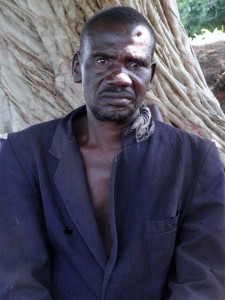
An accused wizard in Yendi who had a nail hammered into his head
The wizard on the far end of the bench catches my eye. He’s dressed in an oddly fashioned royal blue jacket; it looks like something that a sea captain might wear. He has a massive scowling face, and I notice a strange indentation on his head. He tells me that he was accused of witchcraft by two young boys who said they saw a vision of him in their sleep. He was beaten by a number of different men, approximately a dozen times. Then, one day they held him down and pounded a nail into his skull. The nail is still in his head and he can no longer see out of his left eye.
I take a dozen pictures of him, like he’s an animal at a zoo, and then give Simon the wave that means I’m finished. I toss my Yendi translator a weird psychedelic eagle t-shirt that was sitting in my bag–his shirt has more holes than cloth–and bump fists with the remaining wizards before leaping on the back of the motorcycle. We have to push it to get back to Tamale before dark, and I bob up and down as the bike plunges through rut after rut.
Back in Tamale, I pay Simon $40 for five days of work. It comes out to $2 per hour and it’s more than he’s made in the last month. We sleep in a terrible hotel–everything else is booked because of a convention–and I wake up in the morning to a cockroach sidling up my leg. I head to the bus station and two hours later I am riding on the big, comfy STC passenger bus back to Accra. I’m done with Gambaga. I sleep the whole way; I need it badly. I haven’t slept right in a week.
Visit the Gambaga archive for the first three posts in this series or check out the photo gallery for more images from the witch camps of North Ghana.





